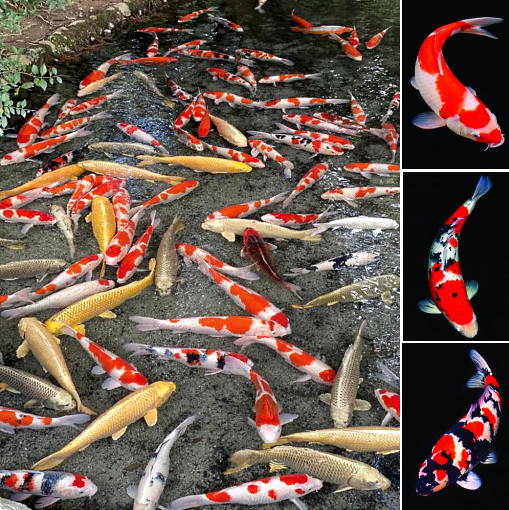By Lee San
While having dinner with Chuan, he politely sought my understanding, and then stared into his mobile phone attentively for at least 15 minutes. Actually he was busy with online nishikikoi bidding, probably a new fad during the coronavirus pandemic, huh! It's said that the bidding price could start from RM500, RM1,000 to upward of RM10,000, with the highest bidders vowing to win the bid. I could see that Chuan was completely engrossed in it, and it doesn't matter whether he eventually won or lost the bid, he was back at the dining table very soon afterward as if nothing had happened, continuing to chatter about everything else with the rest of us.
Of course, he would become instantly overexcited each time we touch on his favorite topic, nishikikoi. As a matter of fact, there are many others like him in this world, super crazy about the fish.
I remember there were times I took the groups to the ancient town of Gujo Hachiman in Gifu prefecture, Japan, I would never forget to introduce to my guests the colorful nishikikoi swimming in the crystal clear water of drains in front of the houses there. The puzzled tourists would invariably ask: You mean the carps can actually survive inside the drains? This is not the only place in Japan where you get to see nishikikoi in drains. The same marvel can also be seen in several drains inside Ritsurin Garden in Matsuyama prefecture in Shikoku, as well as other parks, temples and schools all across Japan!
More than 70% of Japan's nishikikoi are exported to countries around the world, mostly from the breeding farms in Niigata prefecture. Nishikikoi breeding has been practiced there for over two centuries now, and the only thing the breeders do in their entire lives is to breed the topmost quality of nishikikoi. As for the excess fish not bound for oversea markets, they will be given away to municipal councils across the country which will in turn distribute them to various institutions, brightening up the drains and ponds all over Japan with the striking colors of nishikikoi.

Nishikikoi is a luxurious ornamental fish developed through generations of research by the breeders. Prior to the second world war, it was known as flower carp and other names. As a matter of fact, nishikikoi belongs to the Cyprinidae family which had its origins in Central Asia. The Cyprinidae family has about 210 genera and more than 3,700 species, including the edible carp. In the 18th century, the Chinese imperial court presented carps as a gift to the Crown Prince of Japan, signaling the start of a glorious chapter in Japan's nishikikoi breeding history. In 1969, Japan even launched a "National Fish Award", the most prestigious contest event in the world for nishikikoi connoisseurs to show off their most prized pet fish.
Today, even though there are nishikikoi breeding technologies in many parts of the world, the 20 villages in Ojiya City in Niigata prefecture remain the most preeminent nishikikoi breeding base and the ultimate choice of international nishikikoi enthusiasts. Just as the Tajiri wagyu, the nishikikoi also has its "ancestor", namely the Gosanke made up of Kohaku, Taisho Sanshoku and Showa Sanshoku. Almost all the nishikikoi have derived from these three variants. From there new improved variants have been developed over the years, among them the most celebrated being the German Showa, Tanchokohaku, Peacock, Tea Carp, Butterfly Carp and hundreds or probably thousands others. Their most eye-catching features are their glossy body hue, varied markings on their backs, and slender and gracious bodyline. A more luxurious way of enjoying nishikikoi is to purchase the exorbitantly priced fish and then keep it in the seller's mountain stream pond, not unlike storing the most valued red wine at the seller's cellar. Actually, these expensive carps may have problems surviving outside the Japanese water source, being susceptible to KHV infection or discoloration of their body markings.
Although I do not keep any nishikikoi at home, I can always view these "swimming gemstones" in Chuan's house or anywhere in Japan. Although each nishikikoi is unique in its coloring and patterning, I am actually more concerned about the first impression I have when I meet one for the very first time. If you observe it closely, it won't be hard to feel the serenity and peace of nishikikoi, and the peaceful temperament it exudes. If you look carefully at its tail, you will see a perfect blend of natural graciousness and steadiness. As such, nishikikoi is extremely noble, the captivating colors and patterns on its body resembling a beautiful poem on a painting! It is an artistic masterpiece that swims, a spiritual beauty that vows to purge the beholder's many troubles and worries.
I have a feeling that Chuan seems to have inherited the unique characteristics of nishikikoi: composed, calm, low key, yet classy. He loves to make new friends but will never claim to be the big brother. A true gentleman indeed.
Let me add that there's no such thing as tai kor in the world of fish. The big fish will never bully the smaller and weaker ones. As for nishikikoi, they are inherently elegant and love to swim spiritedly in groups but at times appearing still, always tranquil and graceful. Another thing, nishikikoi lives very long, and if you keep it well, it could be a companion for life!
P/S: The 200-year nishikikoi breeding history has apparently evolved into a "carp evolution science" that has spawned large numbers of nishikikoi experts and aficionados. These people are much more than just breeders or connoisseurs, but have happily perpetuated nishikikoi's care-free spirit in their day-to-day lives, too.
(Lee San is Founder and Group Executive Chairman of Apple Vacations. He has traveled to 132 countries, six continents, and enjoys sharing his travel stories and insights. He has also authored five books.)
ADVERTISEMENT
ADVERTISEMENT


































